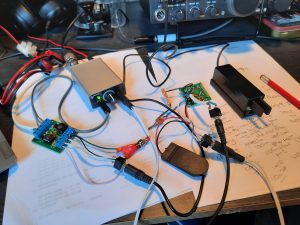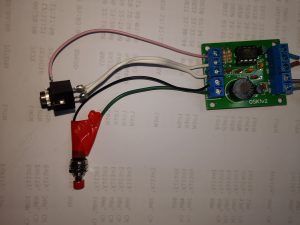 Over the last month I’ve had a lot of fun with my Rooster rig. The build was described in a previous post.
Over the last month I’ve had a lot of fun with my Rooster rig. The build was described in a previous post.
It’s xtal-controlled on 7.030 MHz – the 40m qrp frequency – and with a 12 volt supply my power meter reads 1 watt out.
The current set-up with added peripheral circuits and my Palm paddle is shown in the photo left.
I soon decided that I needed to add an electronic keyer. My traditional telegraph key, hand-made by G0NVT, is a lovely piece of engineering and a delight to use. However, I’m out of practice and can only manage a couple of QSOs before fatigue sets in!

The Rooster’s sidetone was quite loud relative to daytime signals so I changed capacitor C16, that sets the sidetone volume, for one that’s half the value and this quietened it down.
Night-time signals are very loud and the Rooster lacks a volume control. Club members made a number of suggestions as to how I could add one, and inserting a 50k ohm potentiometer (the value used in the earlier Foxx 3) between the phone jack and the headphones seemed the most feasible solution.
I haven’t yet done this. I only use the rig in daylight hours as 40m band conditions in the winter evenings are not currently suitable for my qrpp.
The other addition is a
Sotabeams dual bandwidth audio filter (photo right). This comes ready-built and just needs wiring up for power, bandwidth switching and audio in and out. I power it from a pp3 battery.

This makes a huge difference to selectivity, and is an improvement on the Roosters own active audio filter.
My winter antenna is a 120ft inverted L fed against radials laid around the garden. With current band conditions I’ve mainly been working inter-G during the day and western European stations later in the afternoon – usually F, DL, I and PA.
Many of my contacts are responses to my CQs (inevitably, as I’m restricted to one frequency), and often from qrp stations.
Signal strength reports I’ve received vary from s3 to s7. Using RBN, I can see occasional spots from around 1000 miles – OH, EA, TF and I. Some are just above the noise while others are reasonably strong.
It will be interesting to see if I can get across the pond to W or VE as we move into the spring and band conditions change.
I haven’t yet put the keyer or audio filter in enclosures so the operating desk is a bit of a rats nest at the moment, as you can see from the first photo.
Overall, a fun project to see what I can work using a very simple set-up compared with my main rig – an Elecraft K3S!
 Over the last month I’ve had a lot of fun with my Rooster rig. The build was described in a previous post.
Over the last month I’ve had a lot of fun with my Rooster rig. The build was described in a previous post.  The Rooster’s sidetone was quite loud relative to daytime signals so I changed capacitor C16, that sets the sidetone volume, for one that’s half the value and this quietened it down.
The Rooster’s sidetone was quite loud relative to daytime signals so I changed capacitor C16, that sets the sidetone volume, for one that’s half the value and this quietened it down.

